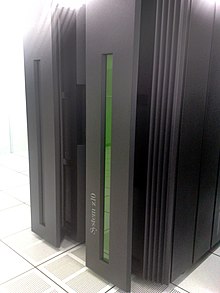
Back Z/OS Azerbaijani Z/OS Catalan Z/OS Czech Z/OS German Z/OS Spanish زد/اواس Persian Z/OS Finnish Z/OS French Z/OS HE Z/OS Italian
This article's tone or style may not reflect the encyclopedic tone used on Wikipedia. (March 2021) |
| Developer | IBM |
|---|---|
| Written in | primarily PL/X, HLASM, and C/C++[1] |
| OS family | |
| Working state | Current |
| Source model | Closed source with open source components. |
| Initial release | March 30, 2001 (V1R1, announced October, 2000) |
| Latest release | Version 3.1 (V3R1) / September 29, 2023 |
| Marketing target | Enterprise / Mainframes |
| Available in | English and other languages |
| Package manager | SMP/E |
| Platforms | z/Architecture |
| Kernel type | Monolithic (uniquely hardware-assisted) |
| Userland | MVS, UNIX System Services |
| Default user interface | ISPF, z/OS Management Facility |
| License | Proprietary monthly license charge (MLC); pricing available based on actual use (VWLC, EWLC, AWLC, EAWLC, IWP); reduced pricing options (zELC, zNALC, "Solution Edition") for many applications |
| Official website | ibm |
| History of IBM mainframe operating systems |
|---|

z/OS is a 64-bit operating system for IBM z/Architecture mainframes, introduced by IBM in October 2000.[2] It derives from and is the successor to OS/390, which in turn was preceded by a string of MVS versions.[NB 1] Like OS/390, z/OS combines a number of formerly separate, related products, some of which are still optional. z/OS has the attributes of modern operating systems but also retains much of the older functionality that originated in the 1960s and is still in regular use—z/OS is designed for backward compatibility.
- ^ Giorgio, Anthony (30 July 2015). "We are the IBM z/OS development team. AUA! • r/IAmA". reddit. Retrieved 19 June 2017.
- ^ Vijayan, Jaikumar. "Z/OS: Users Expect Big Savings." Computerworld, 19 November 2001, Vol. 35 Issue 47, p. 40
Cite error: There are <ref group=NB> tags on this page, but the references will not show without a {{reflist|group=NB}} template (see the help page).